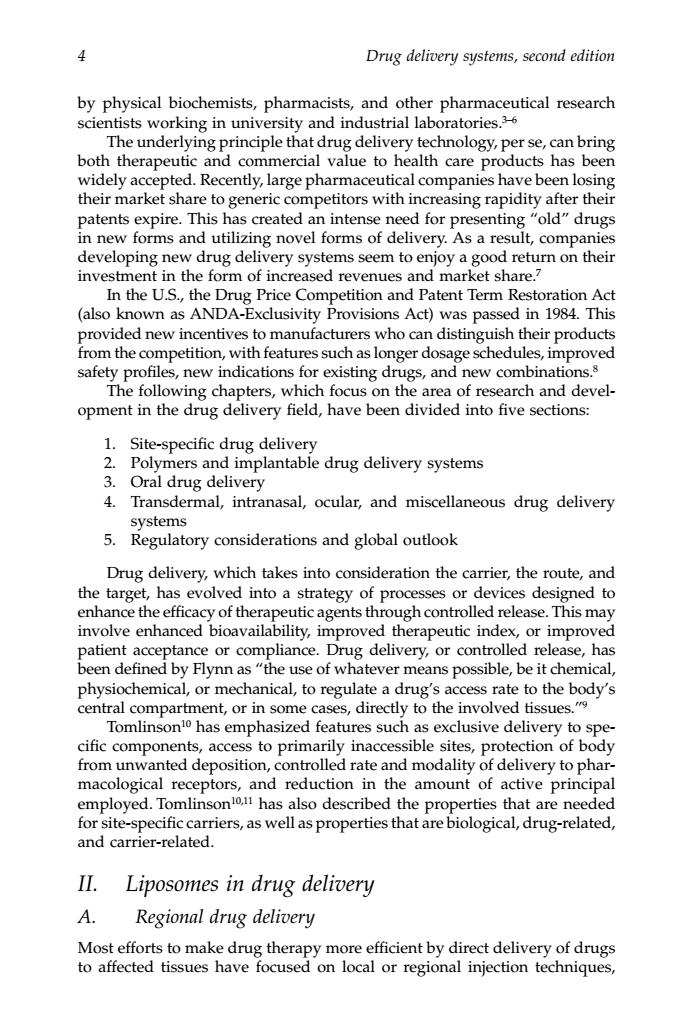正在加载图片...

4 Drug delivery systems,second edition by physical biochemists,pharmacists,and other pharmaceutical research scentiss working in university and industrial laboratories The underlying principle that drug delivery technology,per se,can bring both therapeutic and commercial value to health care products has been widely accepted.Recently,large pharmaceutical companies have their market share to generic competitors with in sing rapidity after thei patents expire.This has created an intense need for presenting"old"drugs in new forms and utilizing novel forms of delivery.As a result,companies developing new drug delivery systems seem to enjoy a good return on their investment in the form of increased revenues and market share.? In the U.S.,the Drug Price Competition and Patent Term Restoration Act (also kr own as ANDA-Exclusivity Provisic ons Act)wa s pa sed in 1984.This provided new incentives to manufacturers who can distinguish their products from the competition,with features such as longer dosage schedules,improved safety profiles,new indications for existing drugs,and new combinations.s The following chapters,which focus on the area of research and devel- opment in the drug delivery field,have been divided into five sections: ers and in mplantable drug delivery systems 3.Oral drug delivery Transdermal,intranasal,ocular,and miscellaneous drug delivery systems 5.Regulatory considerations and global outlook Drug delivery,which takes into consideration the carrier,the route,and the target,has evolved into a strategy of processes or devices designed to enhance the efficacy of therapeutic agents through controlled release.This may involve enhanced bioavailability,in proved the rapeutic index,or im od patient by Flvmn as"the use of whatever means possibleb or comp liance. Drug delivery,or contr rele physiochemical,or mechanical,to regulate a drug's access rate to the body's central compartment,or in some cases,directly to the involved tissues." Tomlinsont0 has emphasized features such as exclusive delivery to spe acc ss to ph imarily inacc ssible sites of body from uny vanted con 11 d rate a nd modality of delivery to pha macological receptors,and reduction in the amount of active principa employed.Tomlinson10n has also described the properties that are needed for site-specific carriers,as well as properties that are biological,drug-related, and carrier-related. Liposomes in drug delivery A. Regional drug delivery Most efforts to make drug therapy more efficient by direct delivery of dru to affected tissues have on local or regional injection techniques 4 Drug delivery systems, second edition by physical biochemists, pharmacists, and other pharmaceutical research scientists working in university and industrial laboratories.3–6 The underlying principle that drug delivery technology, per se, can bring both therapeutic and commercial value to health care products has been widely accepted. Recently, large pharmaceutical companies have been losing their market share to generic competitors with increasing rapidity after their patents expire. This has created an intense need for presenting “old” drugs in new forms and utilizing novel forms of delivery. As a result, companies developing new drug delivery systems seem to enjoy a good return on their investment in the form of increased revenues and market share.7 In the U.S., the Drug Price Competition and Patent Term Restoration Act (also known as ANDA-Exclusivity Provisions Act) was passed in 1984. This provided new incentives to manufacturers who can distinguish their products from the competition, with features such as longer dosage schedules, improved safety profiles, new indications for existing drugs, and new combinations.8 The following chapters, which focus on the area of research and development in the drug delivery field, have been divided into five sections: 1. Site-specific drug delivery 2. Polymers and implantable drug delivery systems 3. Oral drug delivery 4. Transdermal, intranasal, ocular, and miscellaneous drug delivery systems 5. Regulatory considerations and global outlook Drug delivery, which takes into consideration the carrier, the route, and the target, has evolved into a strategy of processes or devices designed to enhance the efficacy of therapeutic agents through controlled release. This may involve enhanced bioavailability, improved therapeutic index, or improved patient acceptance or compliance. Drug delivery, or controlled release, has been defined by Flynn as “the use of whatever means possible, be it chemical, physiochemical, or mechanical, to regulate a drug’s access rate to the body’s central compartment, or in some cases, directly to the involved tissues.”9 Tomlinson10 has emphasized features such as exclusive delivery to specific components, access to primarily inaccessible sites, protection of body from unwanted deposition, controlled rate and modality of delivery to pharmacological receptors, and reduction in the amount of active principal employed. Tomlinson10,11 has also described the properties that are needed for site-specific carriers, as well as properties that are biological, drug-related, and carrier-related. II. Liposomes in drug delivery A. Regional drug delivery Most efforts to make drug therapy more efficient by direct delivery of drugs to affected tissues have focused on local or regional injection techniques